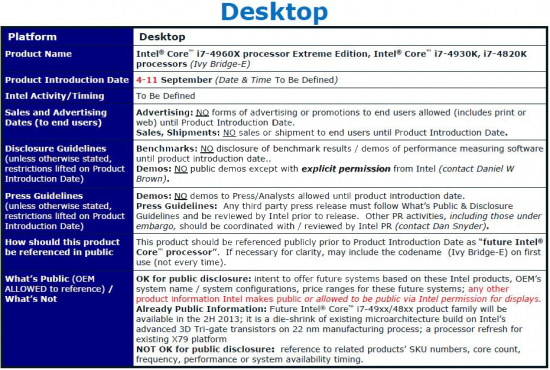Rumors on Ivy Bridge-E: 3 SKUs, September Release?
by Ian Cutress on June 20, 2013 6:51 AM EST- Posted in
- CPUs
- Ivy Bridge-E
A performance enthusiast always wants to know what is coming next. This morning HardwareLuxx published a rather interesting and official looking Intel slide detailing information about the upcoming enthusiast platform, Ivy Bridge-E. While we cannot confirm the legitimacy of the slide, it does follow several patterns we had been assuming for a while.
Firstly the launch date is a little surprising. Initially we have all been discussing October/November, but this slide puts the launch squarely at the beginning of September, between the 4th and the 11th. This is around the same date as IDF San Francisco, held on the 10-12th September.

As with previous launches, there will be a strict NDA date for media to publish results and demonstrations. Judging by what is written there does not seem to be much room for an upgrade to new chipsets, meaning that X79 is still the platform of choice at this time. I would not mind seeing an X89 with a full set of SATA 6 Gbps and USB 3.0 in the near future.
Alongside release details, CPU-World has posted information on the processor SKUs which are expected to be released. The top SKU is to be an i7-4960X, featuring 6 cores (12 threads) at 3.6 GHz which turbos up to 4 GHz and a total of 15MB L3 cache. This is going to be our top end SKU, which normally retails for $999-$1099. Below this is the i7-4930K, also 6 cores (12 threads) but set at 3.4 GHz with turbo up to 3.9 GHz and 12MB L3 cache. The final SKU should be the more interesting – the i7-4820K. The –K moniker suggests this part is unlocked, but unfortunately it is only a quad core (8 threads) part with 10MB L3 cache.
| Ivy Bridge-E SKUs (predicted) | |||||
|---|---|---|---|---|---|
| SKU | Cores / Threads | Speed / Turbo | L3 Cache | TDP | Memory |
| i7-4820K | 4/8 | 3.7 GHz / 3.9 GHz | 10 MB | 130 W | DDR3-1866 |
| i7-4930K | 6/12 | 3.4 GHz / 3.9 GHz | 12 MB | 130 W | DDR3-1866 |
| i7-4960X | 6/12 | 3.6 GHz / 4.0 GHz | 15 MB | 130 W | DDR3-1866 |
One of the main benefits of Nehalem but a big issue with Sandy Bridge-E was the lack of a cheap overclocking SKU – while the i7-920 had big success, the i7-3820 eventually came along but it was not enough. This Ivy Bridge-E low end SKU is going to be directly compared with the i7-4770K Haswell SKU, and the only thing going for it is the quad channel memory support, as it loses at IPC. All three IVB-E CPUs should come in at 130W TDP, and as an overclocker I am hoping that the Ivy Bridge overheating issues are sorted with the IVB-E processors.
Source: HardwareLUXX, CPU-World










48 Comments
View All Comments
blanarahul - Thursday, June 20, 2013 - link
First!blanarahul - Thursday, June 20, 2013 - link
I don't think the IVB heating issues will sorted out (I am looking at you Haswell).Death666Angel - Thursday, June 20, 2013 - link
There is a good chance they will stick with soldering for these enthusiast platforms. Anything less would get even more of a backlash than on the LGA1155/-50 sockets.Rumpelstiltstein - Thursday, June 20, 2013 - link
Why would they do that? They want you to spend more for the crappy bin 4820K over the top of its class 4770K. They gotta stick it to you somewhere with the 4770K in order to get you to do this.extide - Thursday, June 20, 2013 - link
If the 4820K is anything like the 3820, then it is not a binned and partly disabled chip.dragonsqrrl - Monday, July 8, 2013 - link
extide is right. the 3820 uses a different die than the 3930K or 3960/70X. It's a native quad-core die, as opposed to the fused-off octa-core die in its higher-end siblings.piroroadkill - Thursday, June 20, 2013 - link
Ivy Bridge and Haswell did something unexpected - they made Sandy Bridge-E look even better, with their stupid IHS design and limited improvements on the desktop.Ivy Bridge-E is a total waste of time, seeing as Haswell-E has already been announced, with 8 cores.
Kevin G - Thursday, June 20, 2013 - link
Haswell-E is at least a full year away however.With Broadwell delays on the mobile side and the lack of desktop Broadwell chips, next year Intel will have its enthusiast and consumer segments back in sync for awhile.
HisDivineOrder - Thursday, June 20, 2013 - link
Something tells me Broadwell delays will lead to Haswell-E delays, too.Kevin G - Thursday, June 20, 2013 - link
Why? Haswell-E is on the same 22 nm FinFET process as Ivy Bridge-E and vanilla Haswell.Broadwell is jumping to 14 nm and that is likely a big reason for its delay.